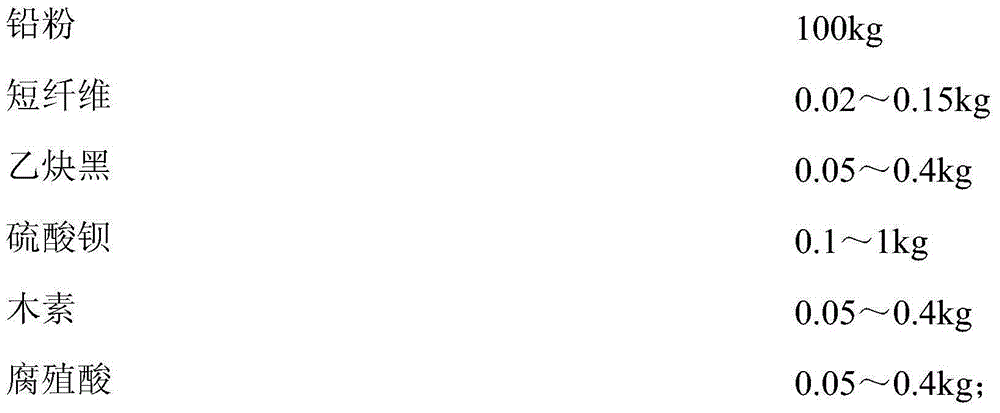Maintenance-free lead-acid storage battery and preparation method thereof
A lead-acid battery, maintenance-free technology, applied in the direction of lead-acid batteries, lead-acid battery construction, batteries, etc., can solve the problems of active material falling off, polluting the environment, affecting the normal use of batteries, etc., and achieve the effect of high-heavy load life
- Summary
- Abstract
- Description
- Claims
- Application Information
AI Technical Summary
Problems solved by technology
Method used
Image
Examples
Embodiment 1
[0066] Positive lead paste: Mix 0.01kg stannous sulfate, 0.1kg antimony trioxide, 0.02kg polyester fiber (fiber length 3-5mm) in advance, and then add 1kg red lead and 100kg lead powder into the paste machine Stir for 3min, stir evenly; Then add 11kg deionized water and 0.15kg polytetrafluoroethylene emulsion (the weight percent concentration of polytetrafluoroethylene emulsion is 40~70%, polytetrafluoroethylene solid particle size is 1~15nm) carries out wet Mix for 3 minutes and stir evenly; then add 6kg of 1.38g / mL (25°C) dilute sulfuric acid dropwise, and keep stirring. , After the paste is finished, the paste can be used when the temperature drops below 45°C.
[0067] Negative lead paste: Mix 0.05kg of polyester fiber (fiber length 3-5mm), 0.1kg of acetylene black, 0.1kg of barium sulfate, 0.2kg of Norway lignin, and 0.3kg of humic acid in advance, and then mix it with 100kg of lead powder Add it to the paste mixer and stir for 4 minutes, and stir evenly; then add 6kg of ...
Embodiment 2
[0069] Positive lead paste: Mix 0.1kg stannous sulfate, 0.05kg antimony trioxide, and 0.15kg aramid fiber (fiber length: 3-5mm) in advance, and then add them to the paste machine together with 3kg red lead and 100kg lead powder Stir for 5min, stir well; then add 12kg deionized water and 0.02kg polytetrafluoroethylene emulsion (the weight percent concentration of polytetrafluoroethylene emulsion is 40~70%, polytetrafluoroethylene solid particle particle size is 1~15nm) carries out wet Mix for 5 minutes and stir evenly; then drop 7kg of 1.38g / ml (25°C) dilute sulfuric acid and keep stirring. , After the paste is finished, the paste can be used when the temperature drops below 45°C.
[0070] Negative lead paste: Mix 0.1kg of aramid fiber (fiber length: 3-5mm), 0.05kg of acetylene black, 0.8kg of barium sulfate, 0.4kg of Norwegian lignin, and 0.1kg of humic acid in advance, and then mix it with 100kg of lead powder Add it into the paste mixer and stir for 10 minutes, and stir eve...
Embodiment 3
[0072] Positive lead paste: Mix 0.2kg stannous sulfate, 0.15kg antimony trioxide, 0.05kg polyester fiber (fiber length 3-5mm) in advance, and then add 10kg Danhong and 100kg lead powder into the paste machine Stir for 12min, stir evenly; Then add 15kg deionized water and 0.11kg polytetrafluoroethylene emulsion (the weight percent concentration of polytetrafluoroethylene emulsion is 40~70%, polytetrafluoroethylene solid particle particle size is 1~15nm) carries out wet Mix for 5 minutes and stir evenly; then add 12kg of 1.38g / mL (25°C) dilute sulfuric acid dropwise and keep stirring. , After the paste is finished, the paste can be used when the temperature drops below 45°C.
[0073] Negative lead paste: Mix 0.15kg polyester fiber (fiber length 3-5mm), 0.3kg acetylene black, 1.0kg barium sulfate, 0.3kg Norwegian lignin, and 0.05kg humic acid in advance, and then mix it with 100kg lead powder Add it to the paste mixer and stir for 10 minutes, and stir evenly; then add 14kg of de...
PUM
| Property | Measurement | Unit |
|---|---|---|
| Fiber length | aaaaa | aaaaa |
| Granularity | aaaaa | aaaaa |
| Density | aaaaa | aaaaa |
Abstract
Description
Claims
Application Information
 Login to View More
Login to View More - R&D Engineer
- R&D Manager
- IP Professional
- Industry Leading Data Capabilities
- Powerful AI technology
- Patent DNA Extraction
Browse by: Latest US Patents, China's latest patents, Technical Efficacy Thesaurus, Application Domain, Technology Topic, Popular Technical Reports.
© 2024 PatSnap. All rights reserved.Legal|Privacy policy|Modern Slavery Act Transparency Statement|Sitemap|About US| Contact US: help@patsnap.com










